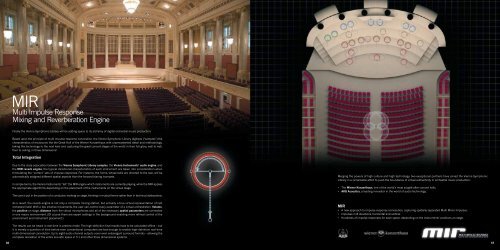ORCHESTRAL STRINGS I - VIENNA SYMPHONIC LIBRARY
ORCHESTRAL STRINGS I - VIENNA SYMPHONIC LIBRARY
ORCHESTRAL STRINGS I - VIENNA SYMPHONIC LIBRARY
Create successful ePaper yourself
Turn your PDF publications into a flip-book with our unique Google optimized e-Paper software.
MIR<br />
Multi Impulse Response<br />
Mixing and Reverberation Engine<br />
Finally the Vienna Symphonic Library will be adding space to its alchemy of digital orchestral music production.<br />
Based upon the principle of multi impulse response convolution, the Vienna Symphonic Library digitizes (“samples”) the<br />
characteristics of enclosures like the Great Hall of the Wiener Konzerthaus with unprecedented detail and methodology,<br />
taking this technology to the next level and capturing the great concert stages of the world in their full glory, wall to wall,<br />
floor to ceiling, in three dimensions!<br />
Total Integration<br />
Due to the close association between the Vienna Symphonic Library samples, the Vienna Instruments’ audio engine, and<br />
the MIR reverb engine, the typical directional characteristics of each instrument are taken into consideration when<br />
formulating the “correct” sets of impulse responses. For instance, the horns, whose bells are directed to the rear, will be<br />
automatically assigned different spatial aspects than the forward blaring trumpets.<br />
In simple terms, the Vienna Instruments “tell” the MIR engine which instruments are currently playing, while the MIR applies<br />
the appropriate algorithms depending on the placement of the instruments on the virtual stage.<br />
The user is put in the position of a conductor, working on stage, thinking in musical terms rather than in technical abstractions.<br />
As a result, the reverb engine is not only a complete mixing station, but actually a true virtual representation of real<br />
orchestral halls! With a few intuitive movements, the user can control every parameter of a virtual orchestration. Volume,<br />
the position on stage, distance from the virtual microphones and all of the necessary spatial parameters are connected<br />
in one macro environment. (Of course there are expert settings in the background enabling more refined control of the<br />
environment and instrument placement.)<br />
The results can be heard in real-time in preview mode. The high-definition final results have to be calculated offline – but<br />
it is merely a question of time before even conventional computers are fast enough to enable high-definition real-time<br />
multi-dimensional convolution. Up to eight audio channel outputs cover even extravagant surround formats – allowing the<br />
complete recreation of the entire acoustic space in 5.1 and other three dimensional systems.<br />
Merging the powers of high culture and high technology, two exceptional partners have joined the Vienna Symphonic<br />
Library in a remarkable effort to push the boundaries of virtual authenticity in orchestral music production:<br />
• The Wiener Konzerthaus, one of the world’s most sought-after concert halls.<br />
• AKG Acoustics, a leading innovator in the world of audio technology.<br />
MIR<br />
• A new approach to impulse response convolution, capturing spatially separated Multi Mono Impulses.<br />
• Impulses in 8 directions, horizontal and vertical.<br />
• Hundreds of impulse responses for each space, depending on the instruments’ positions on stage.<br />
36 37



